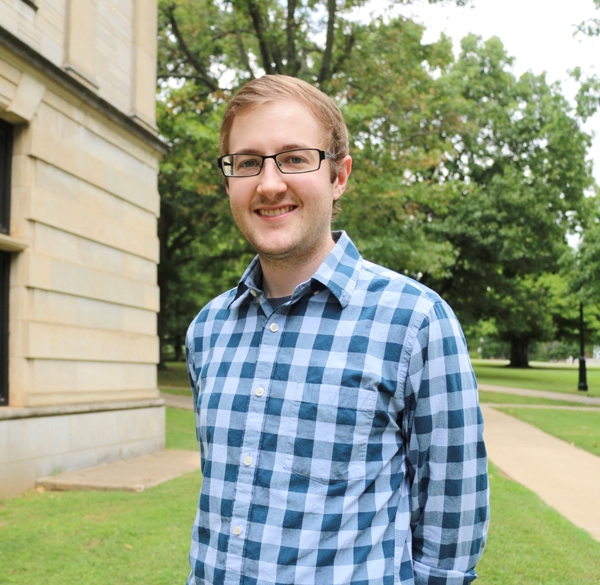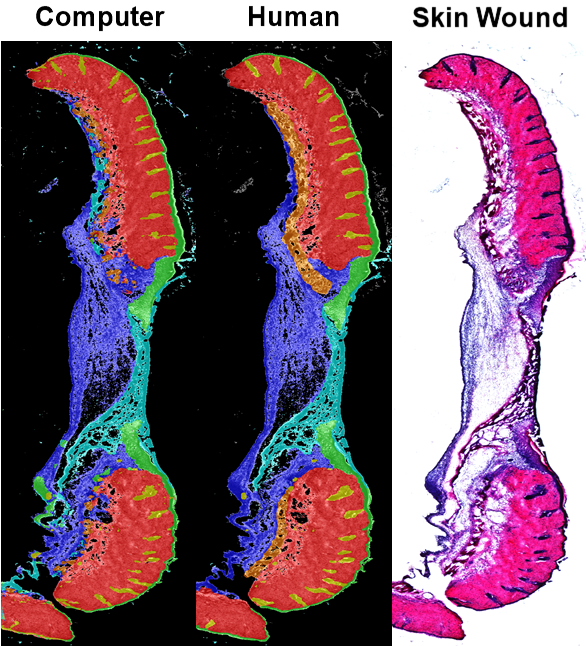
A biomedical engineering doctoral student has been recognized by The Optical Society for his work using machine learning to examine image data sets related to skin wound healing. The research is aimed at saving time and reducing human variability in analyzing images of wounds as they heal.
Jake Jones was awarded the Student Paper Prize in Biomedical Optics from The Optical Society's 2020 Biophotonics Congress.
Jones is advised by Kyle Quinn, assistant professor of biomedical engineering.
His work, titled "Segmenting Cutaneous Wounds from Tissue Sections and In Vivo Images using Deep Learning," focuses on how machine learning can be used to examine tissue samples, saving researchers time and reducing human variability in data analysis.
In current clinical and research settings, wound tissue is stained with vibrant dyes and imaged with microscopes before being analyzed by experts to assess the status of healing.
"In the clinic, a specialized doctor with years of training is asked to assess these tissue images," Jones said. "But two different doctors might make two different assessments, or the same doctor could even assess it differently if they look at it two weeks later. This makes evaluation largely subjective and qualitative, so the goal of this project is to train a computer to recognize and trace out the different tissue features in these images and automatically generate quantitative measurements of wound healing."
 From there, Jones said, the computer algorithm can create a consistent set of results, overcoming limitations in accuracy that have existed with past image processing methods.
From there, Jones said, the computer algorithm can create a consistent set of results, overcoming limitations in accuracy that have existed with past image processing methods.
"The program measures the geometry and shape of different wound features — those can be hard to analyze with traditional approaches," Jones said. "Many diseases, like diabetes, spinal cord injury, and even old age can cause significant variations in how wounds heal, but if you can train a computer to understand those variations, you can provide a tool that's able to accurately assess the healing process in an objective and consistent manner."
The technique could also save valuable time for researchers, Jones said.
"If a researcher wants to conduct a study but has 10,000 images — that obviously represents an extreme time investment if every image needs to be manually measured," he said. "This approach could analyze those images in a few hours, while also providing qualitative measures sensitive to patterns in the data that a human wouldn't recognize by observation alone."
Quinn said the award was a significant achievement and a testament to Jones' resilience through the challenges of COVID-19.
"The OSA Biophotonics Congress is one of the premier meetings in our field," Quinn said. "This much deserved award recognizes Jake's contribution in leading our lab's initial efforts to use deep learning neural networks for image analysis. I am proud of his resilience and adaptability in taking on this new project, moving the project forward amidst a global pandemic, and successfully presenting his work at the OSA meeting despite technical issues with the virtual format."
Jones said he was thrilled to earn the recognition, and thanked fellow doctoral student Alan Woessner as well as undergraduate biomedical engineering students Gianna Busch, Caila Hanes and Ayman Yosef for their help and support.
"I am extremely proud of our graduate students and for Jake's recognition at this international meeting," said Raj Rao, head of the Department of Biomedical Engineering. "This award reflects the high caliber of the research and the active mentorship by Dr. Quinn in guiding our students towards pursuing contemporary integrative research bridging data science and metabolic imaging approaches."
Topics
Contacts
Nick DeMoss, director of communications
College of Engineering
479-575-5697, ndemoss@uark.edu